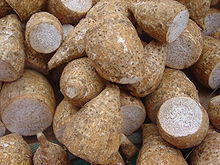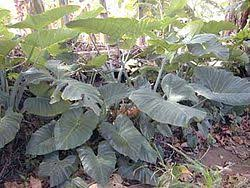Taro
Scientific name: Colocasia esculenta
Climate: Hot and temperate
Plant description: It is an herbaceous plant that will behave perennially if not harvested. It does not have an aerial stem but a subterranean one that reaches a size of six centimeters of diameter or more, from which secondary, lateral, horizontal, thickened branches sprout, which are known as cormels.
The cormels have a dark brown bark and the flesh is white or yellow, with knots from which the buds are born. At its base, the leaves are heart-shaped and measure approximately 40 cm long and 25 cm wide. They have a darker color above, and lighter color below. The growth cycle lasts about 9 to 10 months. During the first six months corms and leaves develop. Taro roots are a staple food in African, Oceanic, South Asian and Carribean cultures. Malanga is believed to have been one of the world's first crops.
Cultivation: Its sowing season is from March to July, but with proper watering it can be sown all year round. It is a plant, like rice, that can grow in swampy conditions. The best seed is the tuber itself, a sprout coming out next to the main tuber. Taro requires a soil rich in potassium; each plant needs space to form its fruit, so they must be sown at a distance of 30 to 45 cm between plants. If a shoot is sown in the spring, it can be harvested in the autumn, or when the leaves turn yellow. Loosen the soil around the plant, and pull from above. The corms are washed, left to dry in the shade and can be stored for many weeks before eating.
It can be planted in full sun or half shade. It is a plant that requires an adequate supply of water throughout its development. A lack of water will have a negative influence on the growth, development and yield of the plant. It prefers soils rich in organic matter, loose sandy or loamy soils and not those that are too muddy like clay.
Uses: It is an edible plant, but it should not be eaten raw. It should be rinsed, soaked and then cooked in any way, such as toasted, boiled or baked. Taro is very rich in vitamins and minerals with plenty of dietary fiber. One serving of taro provides seven grams of fiber, 27% of the recommended daily amount. It is therefore a natural choice to speed up the digestive process and make it much more regular. In this way, it acts as a preventive and nutritional treatment of constipation and cancer of the colon and rectum. Because of its dietary fiber content, it is a good option when it comes to reducing high levels of blood fats, particularly cholesterol levels when they are high.
Pests and diseases: Do not plant the taro too close together, as this could cause root rot. Keep grazing animals away from the plant.
En español: Malanga

